How Do Crystals Grow? Exploring Crystal Habits
By Admin - January 10, 2022
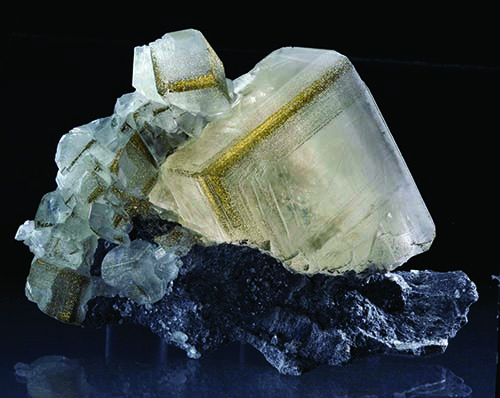
Rhombic crystals of calcite are the regular habit formed in normal atmospheric temperatures. The Arkenstone Gallery of Fine Minerals, http://www.irocks.com
"How do crystals grow is important when describing minerals. There are six recognized crystal systems: isometric, hexagonal, monoclinic, triclinic, tetragonal and orthorhombic. You may come across a seventh system, trigonal. This is a sub-system based on two basic crystal forms in the hexagonal system.
Mineral specimens are commonly described as dendritic, acicular, columnar, striated, botryoidal, banded, and prismatic, acicular.
These terms are the direct result of two things, the mineral’s internal atomic structure and the role it plays in a mineral’s development and the effects of the environment on a mineral during formation.
How Crystals Form
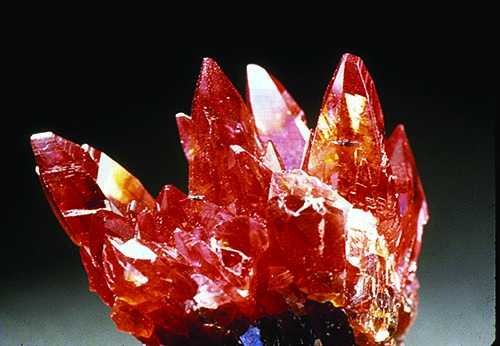
Scalenohedrons, like this specimen from Tsumeb, are just one crystal habit of rhodochrosite.
Crystals develop because of the electron attraction between metals and non-metals that loan, borrow, or share electrons. This ionic sharing during crystal growth creates an imbalance in electron charges. The imbalance attracts more molecules during crystal growth.
The attraction does not extend in all directions. This can determine the direction of growth. If the crystal growth is dominant in one direction, growth develops into a prismatic form we see in tourmaline and quartz. If growth is exclusive to one direction, the crystals are needle-like, which we see in some zeolites, rutile and some stibnite.
Native Copper
When we describe a mineral, we may start by naming its crystal system. But we need to use terms that describe the specimen in far more detail by describing the mineral’s crystal habits. Native copper is an example of this. It is a cubic or isometric mineral.
Cubic copper crystals that have six faces are very uncommon. More common are copper crystals that form as a twelve-sided dodecahedron. In this form, it can almost look like a rounded ball when the faces are tiny.
Most frequently, we find copper in an arborescent or dendritic crystalline form. This develops because of environmental influence.
In a rich solution, as the copper crystallizes rapid molecular electric attraction and growth can create slight irregularities in the unit cells. This causes repeated branching and elongation of the crystallizing copper and arborescent growth. If the growth space is restricted to two dimensions as in a narrow crack, a dendritic form emerges.
Time, Pressure & Temperature
High heat, where crystals form, also determines the formation. Some crystals develop from vapors. Others form in solid rock while it is in a fluid or plastic state. This allows molecules to slowly migrate toward each other and connect to form a crystal.
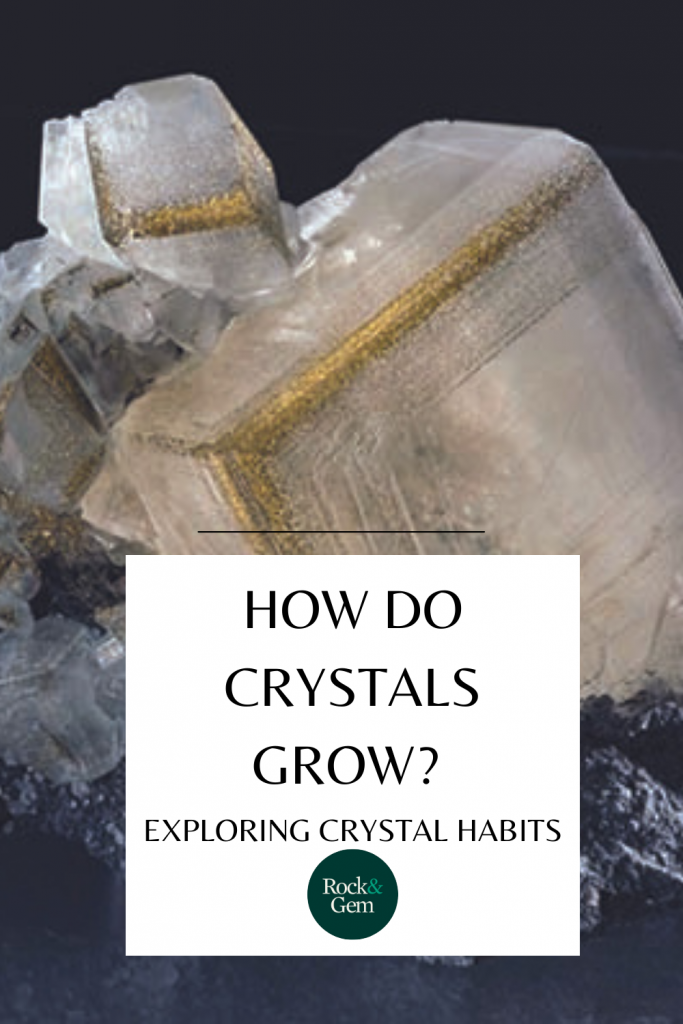
The majority of minerals form in watery solutions that vary widely in mineral content, richness, temperature and pressure. Even the direction the solution is moving can influence how a crystal grows and what form it takes.
Mineral deposits are always described as low, medium or high-temperature deposits. This is important as that energy has a profound influence on what species crystallize out of a solution first.
Each species has its own temperature of crystallization. Some species form first in a pocket or open seam followed by crystals that form at a lower temperature.
Zeolites are late-forming species. They are often found having formed last in a cooling pegmatite pocket full of species that formed first at higher temperatures.
Formation Preferences
If you handle enough mineral specimens, you learn which minerals prefer a particular crystal growth habit. For example, stibnite is always found in long slender needle-like crystals. This indicates rapid or more persistent growth in one direction because of molecular attraction.
Gem tourmalines are almost always striated because of oscillatory growth. This happens when two different crystal forms vie for dominance.
Hematite, on the other hand, is often found in a botryoidal form. It has a penchant for very rapid growth forming radiating needles from a common starting point.
Malachite prefers to form in velvety needle coatings rather than in discrete lengthy prisms. The discrete prisms are the common habit of many species like epidote, kyanite, beryl, and quartz.
Calcite's Unique Crystal Growth
One of the most interesting common mineral species to demonstrate crystal growth habits is calcite. It is found in every mineral environment with both low and high temperatures and climates. It is also found in near-surface sedimentary deposits and much deeper locations.
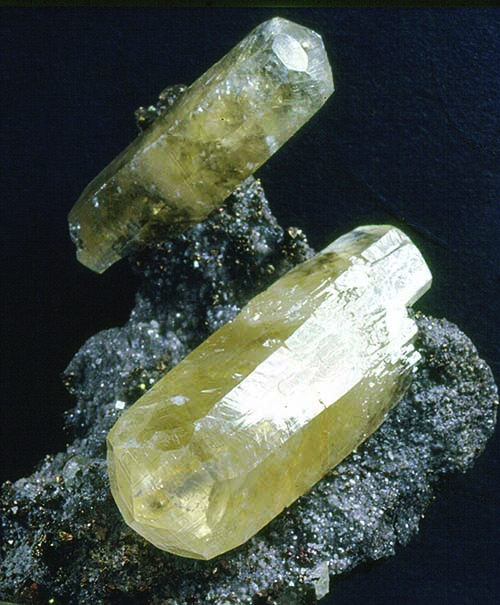
From the Viburnum Trend area, Missouri the common crystal habit of calcite was the classic hexagonal form.
Because of this, calcite manages to develop in at least five basic crystal forms. This is one reason why collecting calcite is widespread and varied.
These different crystal forms, all in the hexagonal-trigonal system, have their growth controlled mostly by the temperature of the environment. The five basic forms calcite takes in crystals are scalenohedrons or dog tooth, tabular, simple hexagonal, rhombic, or disc-like or poker chip form. They are all hexagonal but are not always easily recognized.
Higher temperature solutions are prone to developing calcite that has a scalenohedral or poker chip form. Slightly lower temperature solutions produce calcite crystals with a tabular calcite crystal form. In somewhat lower temperature deposits, simple hexagonal calcite occurs. Rhombic crystals can form from solutions where the solution temperature is at ambient levels.
Solutions around 25°C and lower produce dog tooth crystals. These are common in near-surface sedimentary deposits. This explains why we find small rhombic and dog tooth crystals common in midwest limestone deposits.
This does not mean a particular deposit produces one crystal habit exclusively. Temperatures within a given deposit can vary over time, producing different crystal habits.
Fluorite Crystal Formation
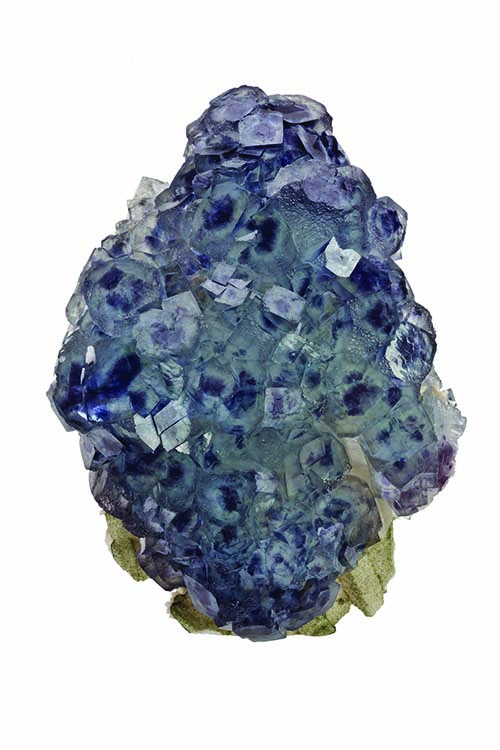
High-temperature mineral deposits are where very complex fluorite crystals often form. The Arkenstone Gallery of Fine Minerals, http://www.irocks.com
Another popular mineral that shows a wide variation in crystal form is fluorite. A major influence on the form of a fluorite crystal is the interplanar distance, which is affected by the energy available during crystallization.
As in calcite, and other species, the variation from low to high energy also affects the complexity of the fluorite crystal formation.
As it happens, octahedrons of fluorite require less energy to form, so we find them as a common form of this calcium fluoride. Cubes require more energy, which is why it is not uncommon to find both octahedrons and cubes of fluorite in the same deposit.
Deposits producing fluorite from higher temperature hydrothermal solutions will produce slightly more complex dodecahedrons. In very high-temperature metal deposits, more complex fluorite crystals are found, some with as many as 24 or even 48 faces.
Molecular Attraction & Crystal Growth
Hopper crystals are good subjects to use to explain molecular attraction and crystal growth. A hopper crystal starts out growing in a solution in a normal way. It attracts like molecules to itself once it starts to grow.
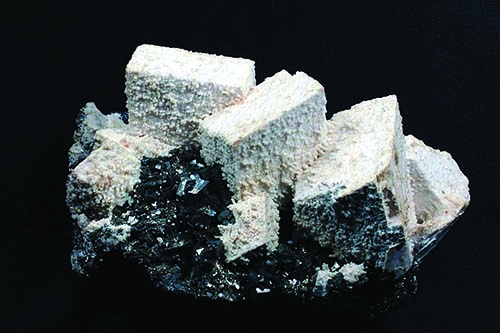
Tabular calcite develops this crystal form in mineral deposits that are high in temperature.
Growth continues consistently but stops when there are no molecules of the mineral left in the solution. This happens with a hopper crystal before it can complete itself. As the molecules are attracted to a growing crystal, they attach sequentially from the prism faces inward. They are not growing from the inside out. They grow from inward.
Molecules first attach to the top outer edge of the growing crystal then continue the growth by filling in the spaces. A sudden stop in the availability of molecules leaves the crystal with a partially filled crown. In some cases, lack of molecules results in crystals around the top edges of the prism faces and leaves the center of the termination unfinished.
Imperfections in Crystal Growth
There are other factors, such as imperfections, that can influence crystal growth. All it takes is one atom or molecule to fail to fit precisely where it belongs and the result can be a change in growth. Sometimes the imperfection marks the beginning of another crystal. ... "
https://www.rockngem.com/on-the-rocks-crystal-habits/